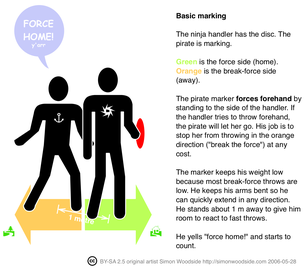Ultimate (sport)
Ultimate, originally known as ultimate Frisbee, is a non-contact team game played by players with a flying disc, flung by human. Ultimate was developed in 1968 by a group of students at Columbia High School in Maplewood, New Jersey.[5] Although ultimate resembles many traditional sports in its athletic requirements, it is unlike most sports due to its focus on self-officiating, even at the highest levels of competition.[6] The term Frisbee, often used to generically describe all flying discs, is a registered trademark of the Wham-O toy company, and thus the sport is not formally called "ultimate Frisbee", though this name is still in common casual use. Points are scored by passing the disc to a teammate in the opposing end zone. Other basic rules are that players must not take steps while holding the disc, and interceptions, incomplete passes, and passes out of bounds are turnovers. Rain, wind, or occasionally other adversities can make for a testing match with rapid turnovers, heightening the pressure of play.
From its beginnings in the American counterculture of the late 1960s, ultimate has resisted empowering any referee with rule enforcement. Instead, it relies on the sportsmanship of players and invokes the "spirit of the game" to maintain fair play.[7] Players call their own fouls, and dispute a foul only when they genuinely believe it did not occur. Playing without referees is the norm for league play but has been supplanted in club competition by the use of "observers" or "game advisors" to help in disputes, and the professional league employs empowered referees.
In 2012, there were 5.1 million ultimate players in the United States.[8] Ultimate is played across the world in pickup games and by recreational, school, club, professional, and national teams at various age levels and with open, women's, and mixed divisions.
The United States has historically won most of the world titles, though not all. US teams won all three divisions (women's, men's, and mixed gender) at the U-24 world championship in 2019,[9] and all divisions in 2016 competitions between national teams.[10][11]
I just remember one time running for a pass and leaping up in the air and just feeling the Frisbee making it into my hand and feeling the perfect synchrony and the joy of the moment, and as I landed I said to myself, 'This is the ultimate game. This is the ultimate game.'
Team flying disc games using pie tins and cake pan lids were part of Amherst College student culture for decades before plastic discs were available. A similar two-hand, touch-football-based game was played at Kenyon College in Ohio starting in 1942.[12]









